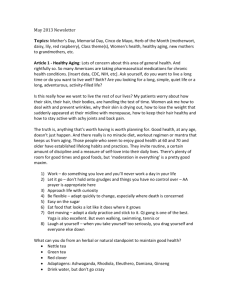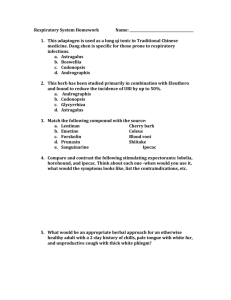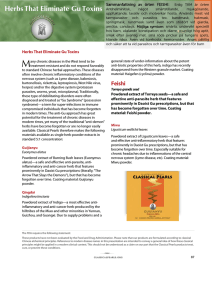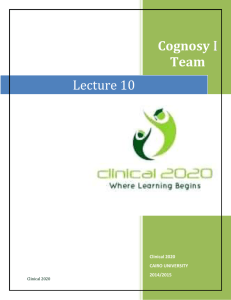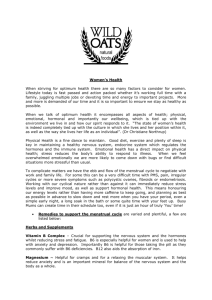Herbert O. House - Organic Syntheses
advertisement
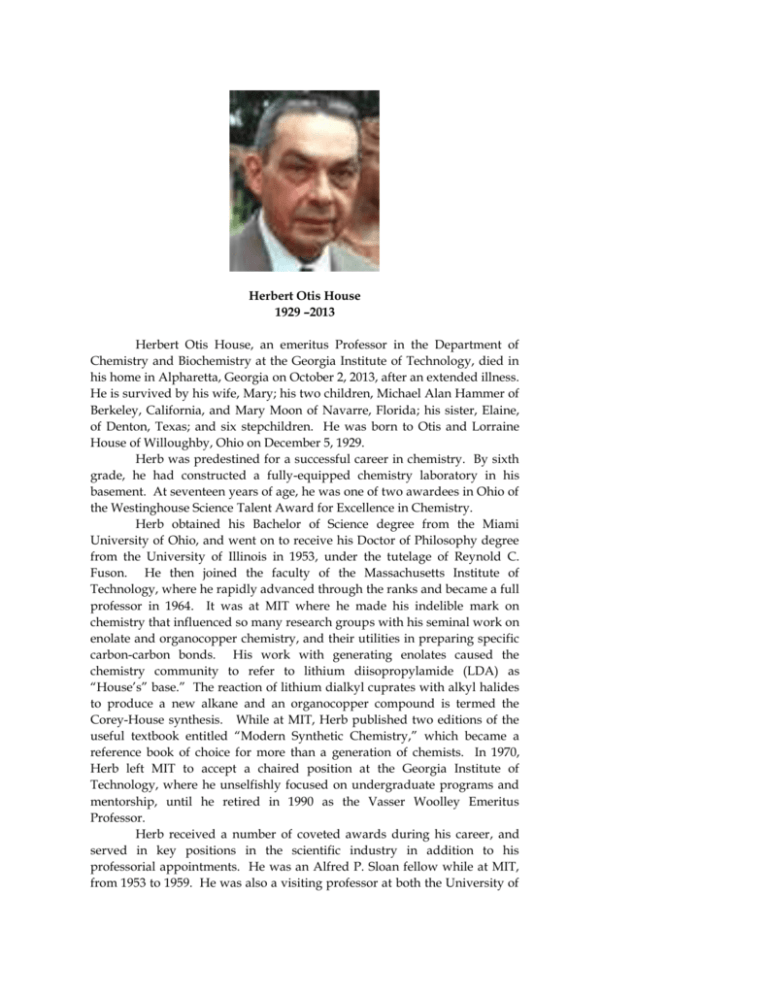
Herbert Otis House 1929 –2013 Herbert Otis House, an emeritus Professor in the Department of Chemistry and Biochemistry at the Georgia Institute of Technology, died in his home in Alpharetta, Georgia on October 2, 2013, after an extended illness. He is survived by his wife, Mary; his two children, Michael Alan Hammer of Berkeley, California, and Mary Moon of Navarre, Florida; his sister, Elaine, of Denton, Texas; and six stepchildren. He was born to Otis and Lorraine House of Willoughby, Ohio on December 5, 1929. Herb was predestined for a successful career in chemistry. By sixth grade, he had constructed a fully-equipped chemistry laboratory in his basement. At seventeen years of age, he was one of two awardees in Ohio of the Westinghouse Science Talent Award for Excellence in Chemistry. Herb obtained his Bachelor of Science degree from the Miami University of Ohio, and went on to receive his Doctor of Philosophy degree from the University of Illinois in 1953, under the tutelage of Reynold C. Fuson. He then joined the faculty of the Massachusetts Institute of Technology, where he rapidly advanced through the ranks and became a full professor in 1964. It was at MIT where he made his indelible mark on chemistry that influenced so many research groups with his seminal work on enolate and organocopper chemistry, and their utilities in preparing specific carbon-carbon bonds. His work with generating enolates caused the chemistry community to refer to lithium diisopropylamide (LDA) as “House’s” base.” The reaction of lithium dialkyl cuprates with alkyl halides to produce a new alkane and an organocopper compound is termed the Corey-House synthesis. While at MIT, Herb published two editions of the useful textbook entitled “Modern Synthetic Chemistry,” which became a reference book of choice for more than a generation of chemists. In 1970, Herb left MIT to accept a chaired position at the Georgia Institute of Technology, where he unselfishly focused on undergraduate programs and mentorship, until he retired in 1990 as the Vasser Woolley Emeritus Professor. Herb received a number of coveted awards during his career, and served in key positions in the scientific industry in addition to his professorial appointments. He was an Alfred P. Sloan fellow while at MIT, from 1953 to 1959. He was also a visiting professor at both the University of California at Berkeley and at Oxford University in England. He received diverse awards from the American Chemical Society, namely, for “Creative Work in Synthetic Chemistry” in 1975 and for “Chemical Health and Safety” in 1983. He was a longstanding member of the Board of Directors for Organic Synthesis, and served as its Editor-in-Chief. He and his students provided many robust preparations for this compendium and also checked many syntheses that were submitted and subsequently accepted for publication. Herb served on the Executive Board of the American Chemical Society and was affiliated with the Swiss Chemical Society. He also served as a consultant to several companies including Union Carbide Corporation. Herb was a very pragmatic person in all aspects of his life. His publications reflect syntheses and methodologies that were designed to be useful to others and to be consistently reproducible. Yields for synthetic steps were never “enhanced.” He provided practical projects for his students, and also taught them to be thorough with laboratory techniques and transcription, and to learn things from the “ground-up”. All students kept a detailed notebook, recorded in duplicate using the MIT notebook format, which he helped to design. In addition, all students submitted a monthly progress report, with experimental sections that were written in Journal of Organic Chemistry style. Every new compound that was prepared was accompanied by a folder that contained all of the original spectral data gathered for that compound. A sample of every new compound was submitted to the group library of compounds. All commercial organometallic reagents were titrated before use, which was no small task. The group gas chromatography laboratory at MIT contained four instruments, which were used for analytical and preparative work. Students packed their own columns, up to thirty feet in length, using the open stairwells in the Dreyfus building that accommodated filling the aluminum tubes with adsorbent, and the subsequent tamping and packing. All yields calculated using gas chromatography methods resulted from first calculating a response factor for the collected product, which was related to an internal standard. Students who matriculated through the House group were very well-versed with the basics of organic chemistry laboratory methods and they left with a good sense of how to use these methods to gather and organize data and perform credible research. An outside of work event that produced an anecdote that underscored Herb’s practical nature was a party in Cambridge at the apartment of one of his postdoctoral students. It was a festive occasion, and after the meal, Herb was given the honor of pouring the brandy over the cherry desert and igniting the mixture to create “Cherries Jubilee.” Herb performed these duties to everyone’s delight, but afterword remarked that “this surely seems to be a waste of perfectly good brandy.” A typical example of Herb’s organization and forward planning was evident at a lecture he presented at Dartmouth College in Hanover, New Hampshire in the fall of 1970. This lecture was not well-publicized at MIT, but one of his graduate students found out that Herb would speak and all of his students decided to drive to Dartmouth and attend this lecture. When Herb arrived at the seminar room he was quite surprised, and pleasantly so, to see all of his students in the audience. After delivering a very informative lecture, the first question came from a new faculty member, seeking to make an impression, who asked a very detailed two-part question. Herb’s response was that “both of these questions are answered on the first of the extra slides.” Of course, after this comment the audience wondered how many extra slides there were and what additional questions they should elicit. Herb did enjoy specific activities outside of work. He was proficient with electronics, and liked working with his hands, and he used these skills to create his own sound system from component parts. Other recreational activities included gardening and hiking. Herb especially enjoyed hiking in the Appalachian Mountains. A favorite pastime was ice skating. Herb enjoyed this activity immensely, and he became an avid pair skating dancer with his wife Mary. Only a few people are blessed with what is referred to as a “photographic memory.” Herb was certainly one of these people. It was not unusual for a student to enter Herb’s office to discuss a particular laboratory procedure and for Herb to then recite the needed reference to that procedure, which included the exact reference with the page numbers. If that particular reference was contained in one of the neatly bound journal volumes in Herb’s office, where he housed an extensive collection, the student was given that volume to photocopy. Herb had an exceptional and encyclopedic memory with respect to chemistry publications. In his career, Herb published 180 research papers, which provided him, and importantly his students, visibility in the scientific community. Herb cared deeply for his graduate students and postdoctoral students, and worked to place them in positions that were appropriate to their skill sets and in environments where they could thrive. These students represent the most important products of his research efforts, and they went on to populate the next generation of academic and industrial scientists. These students are his greatest legacy. Norton P. Peet
